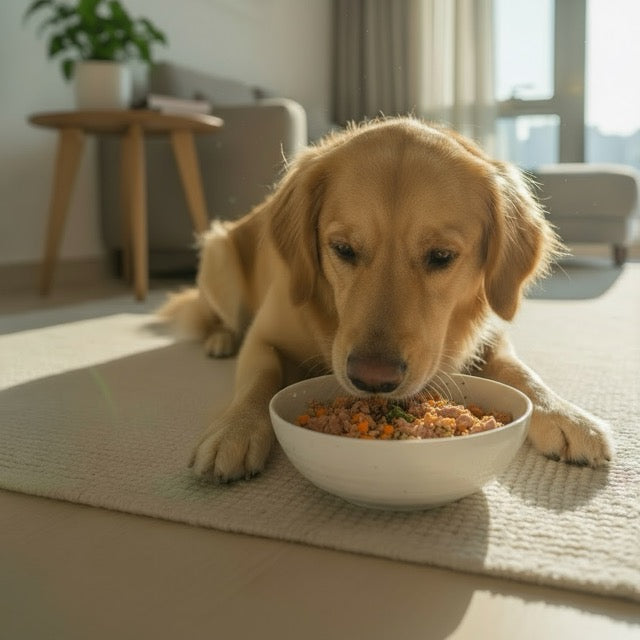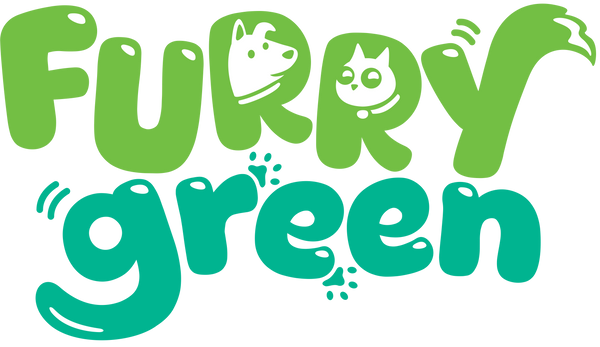
🐾 Managing Food-Related Skin Irritation in Dogs: A Complete Nutrition Guide
Share
Managing Food-Related Skin Irritation in Dogs: A Complete Nutrition Guide
If your dog spends their days scratching, licking paws, or battling red, inflamed skin, you’re not alone. 10–15% of dogs suffer from food allergies, and unlike seasonal triggers, these don’t go away when the weather changes.
The good news? With the right diet strategy, you can uncover your dog’s triggers and give them lasting comfort. This guide explains how -- and shows how Furry Green’s fresh, limited-ingredient meals make the process easier.
📌 Key Takeaways
- Food allergies = immune response to proteins (often beef, dairy, chicken, wheat).
- Fresh, limited-ingredient diets = better control, fewer additives.
- Elimination diets (8–12 weeks) are the gold standard.
- Balanced nutrition matters -- deficiencies alone can cause skin issues.
🔬 Food Allergies vs. Sensitivities

🧪 Food Allergies
An immune system mistakes certain proteins as threats, which leads to inflammation and skin irritation.
Common culprits:
- Beef (32%)
- Dairy (17%)
- Chicken (15%)
- Wheat (13%)
- Soy (6%)
Signs: Chronic itching, ear infections, redness, hot spots, year-round symptoms.
🍗 Food Intolerance
Not immune-related—more about digestion.
Signs: Vomiting, diarrhea, gas, bloating, symptoms resolve quickly after food removal.
👉 Takeaway: Allergies are immune-driven and persistent. Intolerance is digestive and short-term.
🐶 Food vs. Non-Food Skin Problems
| Food-Related | Not Caused by Food (but improved by nutrition) |
|---|---|
| Food allergy dermatitis | Seborrhea (greasy/flaky skin) |
| Hypersensitivity | Immune-mediated diseases |
| Nutrient deficiencies (dull coat, brittle hair) | Hormonal skin conditions |
| Zinc/copper deficiencies | Environmental allergies |
| Poor coat from poor diet | Parasites (fleas, mites, etc.) |
👉 Even if food isn’t the root cause, nutrition supports the skin barrier, healing, and immunity.
🧱 Nutritional Deficiencies: Hidden Causes
Not all skin issues are allergies—sometimes, it’s missing nutrients.
| Nutrient Missing | What It Does | What You’ll Notice |
|---|---|---|
| Protein | Builds skin & hair | Dull coat, fragile skin |
| Omega-3 & Omega-6 | Anti-inflammatory, barrier support | Dry, flaky skin, infections |
| Zinc | Wound healing, coat integrity | Hair loss, thickened skin, ulcers |
| Vitamin A | Skin cell turnover | Rough, scaly skin |
| Vitamin E | Antioxidant | Irritation, slow recovery |
| B Vitamins (Biotin) | Skin & hair metabolism | Thin coat, poor regrowth |
👉 Takeaway: Balanced, complete nutrition equals stronger skin defense.
💚 Furry Green recipes are formulated to cover all these needs.
🥩 The Power of Limited-Ingredient Diets
Why they work:
- Fewer ingredients = fewer triggers.
- Easier to pinpoint allergens.
- Higher-quality proteins.
- No artificial preservatives or fillers.
- Support gut-skin connection.
What to look for:
- Novel protein (duck, venison, kangaroo).
- Simple carbs (sweet potato, pumpkin, peas).
- Anti-inflammatory nutrients (Omega-3, antioxidants).
💚 Furry Green’s single-protein meals check all these boxes—and come pre-portioned for convenience.
🕐 The Gold Standard: Elimination Diet (8–12 Weeks)
Step 1: Stabilization (Weeks 1–8)
✅ Feed ONE new protein + ONE carb.
🚫 No treats, table scraps, or flavored meds.
📓 Track symptoms daily.
Step 2: Challenge (Weeks 9–12)
🔄 Reintroduce ONE old food at a time.
⏱ Wait 2 weeks per food.
⚡ Reaction = confirmed allergen.
Common Pitfalls:
- Family sneaks snacks.
- Helpers not informed.
- Dog scavenges dropped food.
- Flavored meds with hidden proteins.
Success Hacks:
- Use a designated feeding zone.
- Label containers clearly.
- Train household helpers/kids.
- Stick to approved safe treats.
💚 Easier with Furry Green: Pre-portioned, single-protein meals like Duck & Sweet Potato take the hassle out of elimination diets.

Ready for an Itch-Free Dog?
Simplify your elimination diet with Furry Green’s perfectly portioned, single-protein meals. Give your dog the relief they deserve.
Explore Hypoallergenic Meals💎 Essential Nutrients for Skin Health
| Nutrient | Role | Best Sources |
|---|---|---|
| Protein | Builds skin, hair, immune cells | Fresh meats |
| Omega-3s (EPA/DHA) | Reduce inflammation | Fish oil, salmon |
| Omega-6 (Linoleic acid) | Maintain skin membrane | Poultry fat, sunflower oil |
| Vitamin A | Skin turnover | Sweet potatoes, liver |
| Vitamin E | Antioxidant | Seeds, oils |
| B Vitamins | Hair growth & metabolism | Whole grains, meats |
| Zinc | Wound healing | Red meat, shellfish |
| Copper | Hair pigmentation | Liver, legumes |
👉 Look for diets with natural anti-inflammatories: salmon oil, turmeric, blueberries, probiotics.
💚 Furry Green integrates many of these into its recipes for complete skin support.
🛁 Beyond Diet: Extra Skin Support
- Topical Care: Oatmeal shampoos, aloe-based sprays.
- Supplements: Probiotics, Omega-3s, biotin, zinc (if deficient).
- Environment: Clean bedding, air purifiers, regular grooming.
Breed Watchouts:
- Shar Peis/Bulldogs → skin folds, infections.
- Spaniels → ear infections.
- Huskies/Malamutes → zinc-responsive dermatosis.
🚩 When to See a Vet

- Severe infections (odor, discharge).
- Open wounds from scratching.
- No progress after 12 weeks of diet trial.
- GI symptoms (vomiting, diarrhea).
- Signs of systemic illness.
A vet may suggest allergy testing, bloodwork, biopsies, or a referral to a dermatologist.
🌟 Conclusion: A Fresh Start for Sensitive Dogs
Food-related skin irritation is a puzzle—but with patience, structure, and the right diet, you can solve it.
Fresh, limited-ingredient meals like Furry Green simplify elimination diets, ensure balanced nutrition, and support long-term skin health.
✨ Every dog is unique, but every dog deserves comfort. Start with Furry Green’s hypoallergenic recipes today—and watch your dog thrive, itch-free.
❓ Frequently Asked Questions
How do I know if my dog’s skin issues are from food allergies?
If your dog has year-round itching, recurrent ear infections, or red, inflamed skin, food is a likely culprit. Seasonal symptoms that come and go are more often caused by environmental allergens like pollen or dust. The only way to confirm a food allergy is through a structured elimination diet.
How long does an elimination diet take to show results?
Most dogs need 8–12 weeks of strict diet control before symptoms improve. Some show relief within 4–6 weeks, but it’s important to continue the full trial for accuracy. Even a single bite of the wrong food can reset the timeline.
💚 Tip: Using pre-portioned meals like Furry Green Duck & Sweet Potato helps keep things consistent and easy.
Can I just cook my dog’s food at home instead?
Home cooking is possible, but risky. Without precise balancing, dogs can develop nutritional deficiencies (zinc, calcium, vitamins) that actually cause skin problems. For safety, you’d need recipes formulated by a veterinary nutritionist.
💚 Furry Green meals provide the same freshness and simplicity as home cooking—but with complete, balanced nutrition in every pack.
What treats can my dog have during an elimination diet?
Only treats made from the same protein and carb sources as the elimination diet. For example, if you’re feeding duck + sweet potato, any extra treats should also be duck or sweet potato only.
💚 With Furry Green, you can easily make “safe treats” by baking or freezing small portions of their fresh meals.
Will my dog need a special diet forever?
Not always. Once you identify the specific allergen(s), you can sometimes reintroduce other safe proteins and carbs. However, many sensitive dogs do best staying on limited-ingredient, hypoallergenic diets long-term for consistency and comfort.
My dog is still itchy after switching foods -- why?
Food allergies are just one piece of the puzzle. Your dog may also have:
- Environmental allergies (pollen, dust, mold).
- Parasites (fleas, mites).
- Skin infections or hormonal imbalances.
👉 If your dog shows no improvement after 12 weeks on an elimination diet, it’s time to consult your veterinarian.
